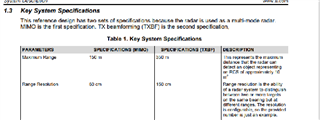Other Parts Discussed in Thread: AWR2243
Tool/software:
Hello,
In User's Guide, Radar spec related with detection range is not written.
Please tell me detection range in each RCS and show me evaluation result if it possible.
Regards,
Yuichi
This thread has been locked.
If you have a related question, please click the "Ask a related question" button in the top right corner. The newly created question will be automatically linked to this question.
Tool/software:
Hello,
In User's Guide, Radar spec related with detection range is not written.
Please tell me detection range in each RCS and show me evaluation result if it possible.
Regards,
Yuichi
Hi Yuichi-san,
I am not sure about which user guide you were pointing to. You can refer to the following document to get more information about range with respect to the radar equation and other parameters.
Regards,
Kaushik
I believe for the cascade EVM, the max range spec is given considering the RCS as described.

You can refer to the following document for more information on that.
Imaging Radar Using Cascaded mmWave Sensor Reference Design (Rev. A) (ti.com)
Regards,
Kaushik
Hello, Mr./Ms.Kaushik,
Thnak you for introducde the information.
The data presented in this design guide was obtained
using MMWCAS-RF-EVM Revision C, that used the
AWR1243P devices.
I want to know the spec the latest MMWCAS RF-EVM Revision D makes use of the second generation, AWR2243 devices.
Please tell me the difference of the detection range between the MMWCAS-RF-EVM Revision C and Revision D.
and introduce the document about Revision D, it there are.
Hi,
We do not have a similar characterization done with the AWR2243 device-based cascade EVM but the numbers should be easily met by the AWR2243 as well. (Also, the AWR1243P was not productized).
Please find the feedback below on the thumb rule to obtain SNR improvements for cascaded cases:
Now, between the 4-Chip 2243 and the 4-Chip 1243P, you should be able to identify the max specs based on your use case by considering the points above and the differences in system parameters as per the datasheet.
Regards,
Kaushik